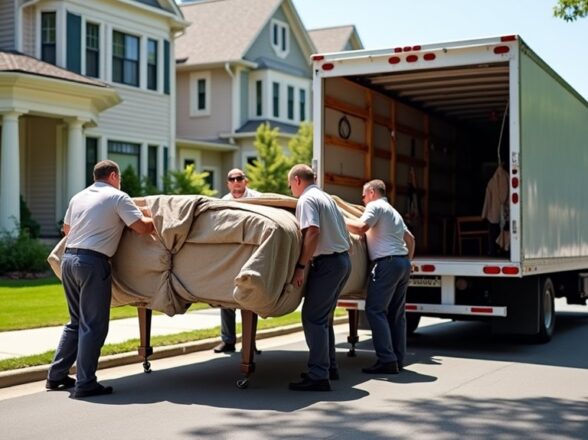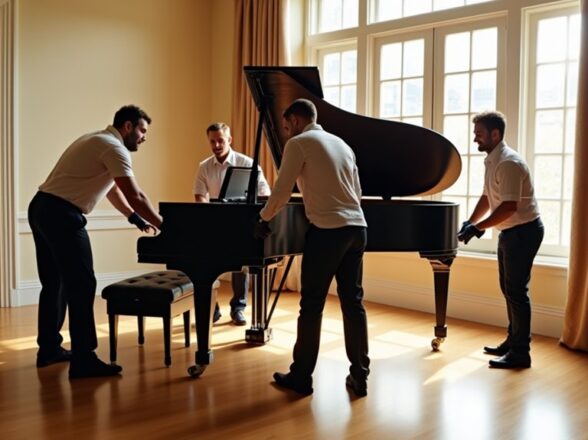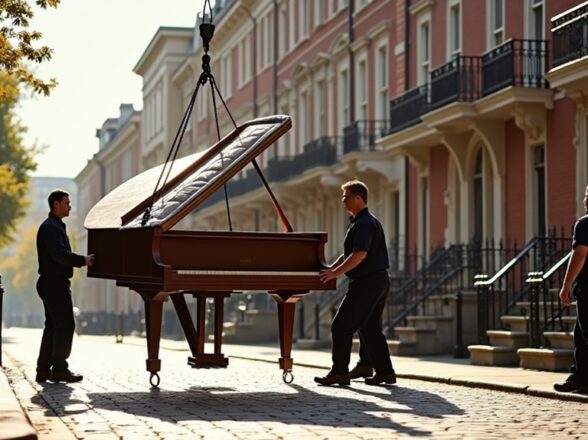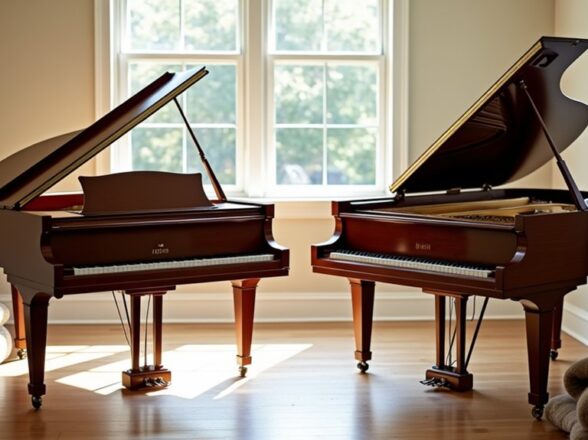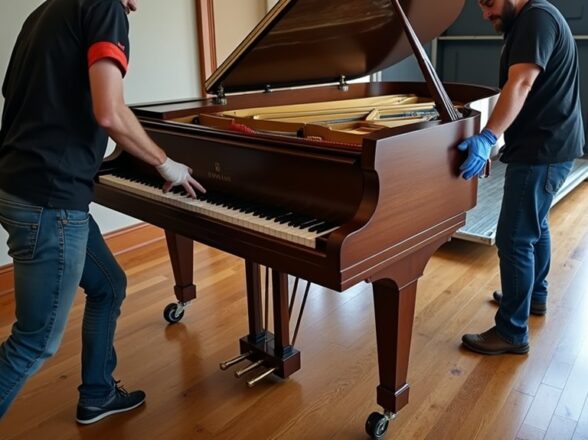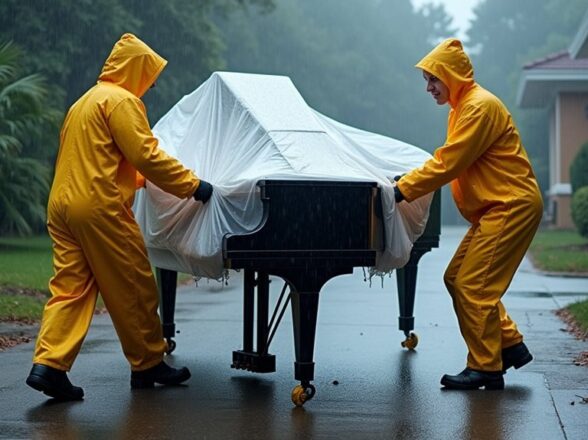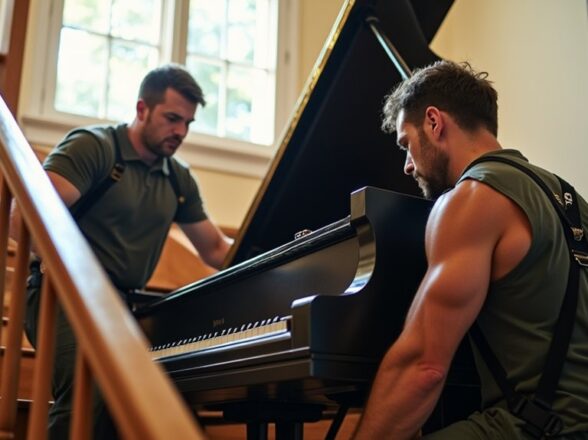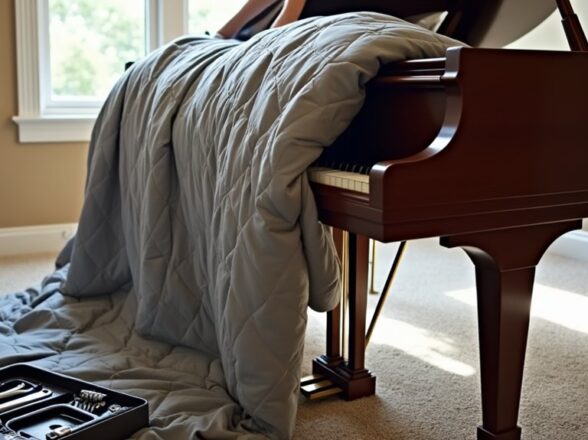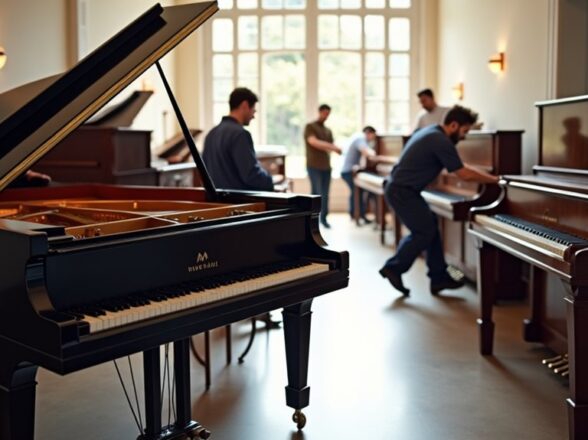What Are the Best Packing Materials for Moving a Piano? Essential Supplies for Maximum Protection

When moving a piano, using the right packing materials guarantees maximum protection. Start with piano moving blankets to shield the surface. Next, wrap the piano in multiple layers of bubble wrap and foam for added cushioning. Consider using a custom piano crate or case for extra safety during transport. Corner protectors will safeguard vulnerable areas. Don't forget high-quality strapping and tie-downs to secure the piano in place. A moving dolly or hand truck simplifies transport. Each of these materials plays a crucial role in preventing damage. You can discover more essential details for a successful move ahead.
Key Takeaways
- Use piano moving blankets for essential padding and protection against scratches and dents during transit.
- Wrap the piano in bubble wrap and foam for shock absorption, especially around delicate areas like keys and pedals.
- Invest in custom piano crates or cases for durable, tailored protection during transport, preventing internal and external damage.
- Utilize high-quality cardboard and packing paper to cushion vulnerable sections, while corner protectors help maintain structure integrity.
- Secure the piano with straps and tie-downs to prevent shifting, ensuring stability throughout the moving process.
Piano Moving Blankets

When it comes to moving a piano, piano moving blankets are essential for protecting your instrument during transit. There are various piano blanket types available, including standard, quilted, and padded options. Each type offers different levels of protection, so choose one that suits your piano's needs. It's important to guarantee these blankets are clean and in good condition before use. Regular blanket maintenance involves washing them according to the manufacturer's instructions and inspecting for any wear or damage. Keeping your blankets in top shape will enhance their effectiveness and prolong their lifespan. By properly selecting and maintaining your piano moving blankets, you can help safeguard your instrument from potential damage during the moving process. Using high-quality packing materials significantly reduces the risk of damage, as professional movers have found.
Bubble Wrap and Foam
Bubble wrap and foam are invaluable tools for safeguarding your piano during a move. Using bubble wrap benefits you by providing a cushioning layer that absorbs shocks and impacts. Start by wrapping the piano in multiple layers of bubble wrap, ensuring all surfaces are covered. This helps protect against scratches and minor dings.
In addition, foam padding offers another layer of protection. You can place foam padding around the most delicate areas, like the keys and pedals. This added security prevents damage from vibrations and sudden movements during transport. Together, bubble wrap and foam create a robust barrier, keeping your piano safe and sound throughout the moving process. Be sure to secure everything tightly to minimize any risk. For optimal protection, consider climate-controlled trucks to shield your piano from temperature extremes and humidity during transit.
Piano Crates and Cases
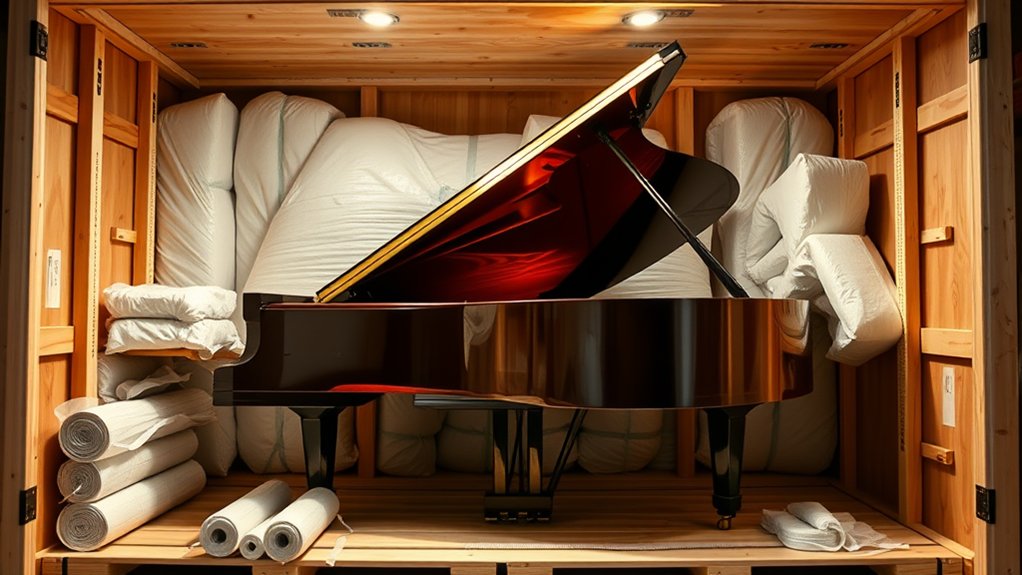
For ideal protection during your move, investing in piano crates and cases is essential. These specially designed containers offer the best custom piano protection, ensuring your instrument remains safe from damage. Various piano transportation methods exist, but using a crate or case provides a sturdy barrier against impacts and environmental factors. Crates are often made from durable wood and are tailored to fit your piano's dimensions. Cases, on the other hand, are more portable and can be easier to handle. Both options are vital for preventing scratches, dents, or internal damage. By selecting the right piano crates and cases, you can have peace of mind knowing your piano is adequately protected throughout the moving process.
Straps and Tie-Downs
When moving a piano, secure strapping is essential to prevent damage during transport. Various types of tie-downs are available, each designed to keep your piano safely in place. Choosing the right straps can make a significant difference in ensuring a smooth move.
Importance of Secure Strapping
Secure strapping is essential for safely moving a piano, as it prevents the instrument from shifting during transport. Using high-quality strap materials guarantees that your piano remains stable, reducing the risk of damage. When you secure the piano tightly, you create a safe environment for it during the move. This is particularly important when traversing bumpy roads or tight corners. Without secure strapping, the piano could slide or tip, leading to costly repairs. Make certain to choose straps designed for heavy loads, as they offer the best support and durability. By prioritizing secure transport, you protect your investment and make the moving process smoother. In the end, your efforts in strapping will pay off with a safe arrival at your destination. Additionally, you might consider using climate-controlled storage to protect the piano from extreme temperatures and humidity if you need to store it temporarily during your move.
Types of Tie-Downs
Several types of tie-downs are available for moving a piano, each designed to meet specific needs during transport. Ratchet straps are among the most reliable options. They provide a secure hold by tightening and locking in place, ensuring the piano stays steady during transit. When using ratchet straps, make sure to attach them to sturdy points on the piano and the moving vehicle. Safety hooks are another essential tool. They help secure the straps and prevent slippage, adding an extra layer of protection. Always inspect your tie-downs for wear and tear before use. Properly securing your piano with these tie-downs minimizes the risk of damage, making your move smoother and safer.
Cardboard and Packing Paper
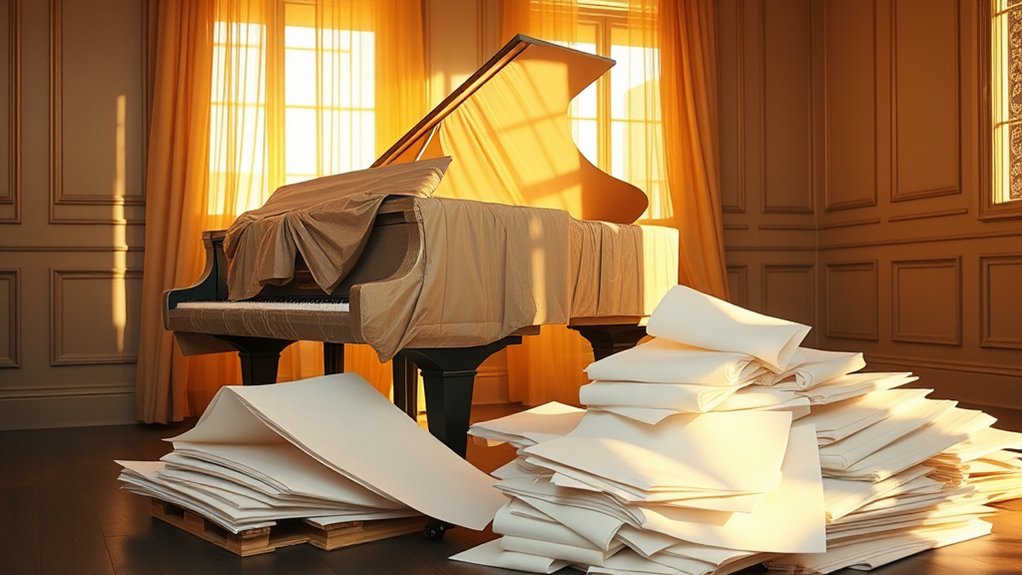
Cardboard and packing paper are essential materials for protecting your piano during a move. When choosing cardboard, look for high-quality options that guarantee cardboard durability. Strong, double-walled boxes can withstand pressure and prevent damage. You'll want to use packing paper types like newsprint or unprinted paper for wrapping delicate areas. These lightweight materials provide cushioning and help absorb shock. As you wrap your piano, make sure to cover all vulnerable sections, like the keys and pedals, to guard against scratches and dents. Packing paper is also great for filling spaces in boxes to prevent movement. Protective wrapping of furniture is an important step to ensure all parts are safeguarded during transport. By using these materials effectively, you can guarantee your piano arrives at its new location in top condition.
Corner Protectors
When packing your piano, don't overlook the importance of corner protectors. These materials are essential for corner damage prevention during the moving process. By using corner protection techniques, you can guarantee that the most vulnerable parts of your piano remain safe from impacts and scratches. Corner protectors come in various forms, such as foam, cardboard, or specialized plastic covers. These options absorb shock and help maintain the integrity of your piano's structure. Make sure to securely attach them to all corners before moving. This simple step can save you from costly repairs and preserve the piano's appearance. Remember, investing in corner protectors is a smart choice for protecting your valuable instrument during its journey.
Moving Dolly and Hand Trucks

When moving a piano, using the right dolly or hand truck is essential for safety and efficiency. You'll want to learn proper loading techniques to secure the piano and prevent damage during transport. Additionally, understanding how to maneuver in tight spaces will help you navigate your home or venue without any hassle.
Choosing the Right Dolly
Choosing the right dolly is essential for safely moving a piano, as the wrong equipment can lead to damage or injury. There are several dolly types to take into account, including upright hand trucks and flat dollies. Upright hand trucks are ideal for vertical lifting, while flat dollies provide a stable base for heavier pianos. When selecting a dolly, verify it has a sturdy frame and adequate weight capacity to support the piano's size. Pay attention to dolly safety features, such as rubber wheels for smooth rolling and straps to secure the piano in place. Using the right dolly not only protects your piano but also makes the moving process more manageable and efficient. Choose wisely to avoid accidents.
Proper Loading Techniques
To guarantee your piano is loaded safely on a dolly or hand truck, start by positioning the instrument correctly. Ascertain the piano is upright and balanced before applying any loading techniques. Use straps to secure the piano to the dolly, preventing it from shifting during transport. When lifting, keep your back straight, and bend at the knees to avoid injury. Always have one person at the front and another at the back for safe handling. Push the dolly rather than pulling it, as this gives you better control. Make sure the path is clear of obstacles to avoid accidents. These simple steps will help guarantee your piano is loaded securely and safely for the move ahead.
Maneuvering Tight Spaces
Successfully loading your piano is just the beginning; maneuvering tight spaces is where the real challenge lies. Using a moving dolly or hand truck can make this task much easier. These tools help you carefully navigate through doorways, hallways, and staircases without straining your back or damaging your piano. When moving in tight spaces, always keep the piano balanced and secure. Make sure to tilt it slightly if you need to turn corners. Take your time and communicate with your helpers to avoid accidents. If the space is particularly cramped, consider removing the piano's legs or pedals to create more room. With the right equipment and careful navigation, you can successfully move your piano safely and efficiently.
Frequently Asked Questions
How Do I Determine the Size of a Piano Crate?
To determine the size of a piano crate, measure the piano dimensions accurately. Then, factor in additional space for padding. Select crate materials that provide durability and protection during transport to guarantee your piano's safety.
Can I Use Regular Blankets Instead of Piano Moving Blankets?
You can use regular blankets for piano protection, but they won't offer the same cushioning as piano moving blankets. Consider investing in quality materials to guarantee your instrument stays safe during the move.
What Is the Best Way to Secure a Piano on a Dolly?
You're about to move a heavy piano, and you can't risk it toppling over. For dolly safety, strap the piano securely with heavy-duty straps, ensuring stability. Check twice—your careful preparation makes all the difference!
How Much Do Piano Moving Supplies Typically Cost?
Piano moving supplies usually range from $50 to $200, depending on quality and quantity. It's smart to factor these costs into your moving budget, ensuring you have adequate packing supplies for safe transport.
Is It Necessary to Hire Professionals for Piano Moving?
While you could attempt moving a piano yourself, hiring professional movers guarantees piano safety. They've got the expertise and equipment to handle the job, reducing the risk of damage to your instrument and your home.
Conclusion
To summarize, using the right packing materials is vital for protecting your piano during a move. While some might think it's too complicated or costly, investing in quality supplies like piano blankets, bubble wrap, and sturdy straps guarantees your instrument arrives safely. This protection can save you from expensive repairs later. By preparing properly and using these essential materials, you can make the moving process smoother and worry-free for your valuable piano.
Related posts
Recent posts
Post Categories
Tags
Subscribe

